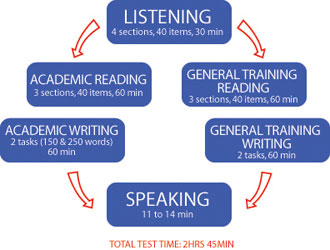IELTS, delineate to evaluate the language proficiency of candidates (Non native speakers) who aspire to study or work in English speaking countries. It is the world"s proven English test .Over 1.4 million candidates proceed the test each year to embark their journeys into international education and employment. It is perceived by over 6,000 organisations worldwide, including universities, employers, professional bodies, immigration authorities and other government authorities. For a list of organisations that approve IELTS scores, visit - http//bandscore.ielts.org
Including foreign Universities, professional bodies, immigration authorities and other government authorities recognized this test worldwide.Visit – bandscore.ielts.org for a list of organizations that approve IELTS score.
The level of the test
IELTS is designed to measure English language skills at all levels. There is no pass or fail in IELTS. Results are based on individual performance and are reported as band score on a scale from 1-9.

BAND :
The band ranges from 1 to 9
9 :
Expert user
8 :
Very Good user
7 :
Good user
6 :
Modest user
5 :
Competent user
4 :
Limited user
3 :
Extremely limited user
2 :
Intermitted user
1 :
Non user
Accessible and Convenient
IELTS is exhibited up to four times a month in more than 125 countries. Tests are usually on Saturday or Thursdays. A list of all IELTS test centres across the globe is available at – www.ielts.org
Test result
Candidate will receive a Test Report form which reports a score for each of the four skills -listening, reading, writing and speaking as well as an overall band score. Results are issued 13 days after the test. At some test centers candidates may collect their results on 13th day, at others results are mailed on the 13th day. Test centres are not permitted to give results over the phone or by fax or email.
Enquiring on Result
If a candidate is unhappy with his test result, he can apply for re-valuation at the centre where you took the test. One must make the application no later than six weeks after the test date .You can choose which test components are re-marked. There is a fee for this service which will be refunded if your score on any component is increased. It takes 6-8 weeks to complete.
Re- taking the IELTS
There are no restrictions on re-taking IELTS. If you do not get the result you wanted, you can register for another test as soon as you feel you are ready to do so. Please note that your score is unlikely to increase unless you make a significant effort to improve your English before re -taking the test.
TEST FORMAT AND STRUCTURE

IELTS test consist of four modules
Listening (4 sections,40 items- 30 minutes)
Each section has 10 questions. The following question types are used in the listening test :
:- Multiple choice
:- Flow chart completion
:- Matching
:- Short answer types
:- Diagram labeling
:- Note completion
:- Form completion
:- Table completion
:- Classification
:- Sentence completion
:- Summary completion
Section 1
A conversation between two people set in an everyday social context.
Section 2
A monologue set in an everyday social context e.g. a speech about local facilities.
Section 3
A conversation between up to four people set in an educational or training context, e.g. a university tutor and a student discussing an assignment.
Section 4
A monologue on an academic subject e.g. a university lecture.
Reading (3 sections, 40 items – 40 minutes)
Each section has 13-14 questions and may have diagrams, graphs and illustrations. The following question types are used in the academic reading test.
The texts are of general interest and are taken from magazines, journals, books and newspaper.
:- Multiple choice
:- Identifying information
:- Matching information
:- Flowchart completion
:- Matching headings
:- Matching sentence endings
:- Diagram label completion
:- Short answer questions
:- Summary completion
:- Sentence completion
Writing (2 tasks)- 60 minutes)
There are two tasks and it is suggested that the candidate spend about 20 minutes on TASK1 which requires them to write at least 150 words and 40 minutes on TASK 2 -250 words
Note - The assessment of TASK 2 carries more weight in marking than TASK1
TASK 1 - Candidates are expected to describe some information contained in a graph/table /pie chart/diagram/process/flow chart.
TASK 2 - Candidates have to write a short essay in response to a topic which is presented as a point of view, an argument or a problem. They are gauge on their ability to present a solution to a problem, present and justify an opinion with relevant examples.
Speaking (3 Parts -11-14 minutes)
There are three main parts:
Part 1 - Introduction
The candidate answers general questions about himself, his home, family, job, studies, interests and a range of familiar areas.
Part 2 - Cue Card
The candidate is given a cue card with prompts and is asked to talk on a particular topic .Candidate is given one minute to prepare notes if he wishes, before speaking for between one or two minutes. After that examiner may ask one or two questions on the same topic.
Part 3 - Extended discourse
The examiner asks candidate further questions which are connected to the topic of part 2.These questions give you an opportunity to discuss more abstract issues and ideas.
Note - The whole speaking test is recorded.
Writing Tasks
9 - Expert user - Fully operational command over language, no mistakes at all and possess high level of accuracy. Can handle complex situation with complete understanding.
8 - Very good user - Desirable operational command over language, occasional unsystematic inaccuracies .
7 - Good user - Posseess operational command over language, occasional inaccuracies and inappropriacies.
6 - Competent user - Effective command of the language, some inaccuracies and misunderstandings, can handle language in familiar situations.
5 - Modest user - Restricted command over language, many mistakes, can handle only basic situations.
HOW TO PREPARE (Techniques and Suggestions)
